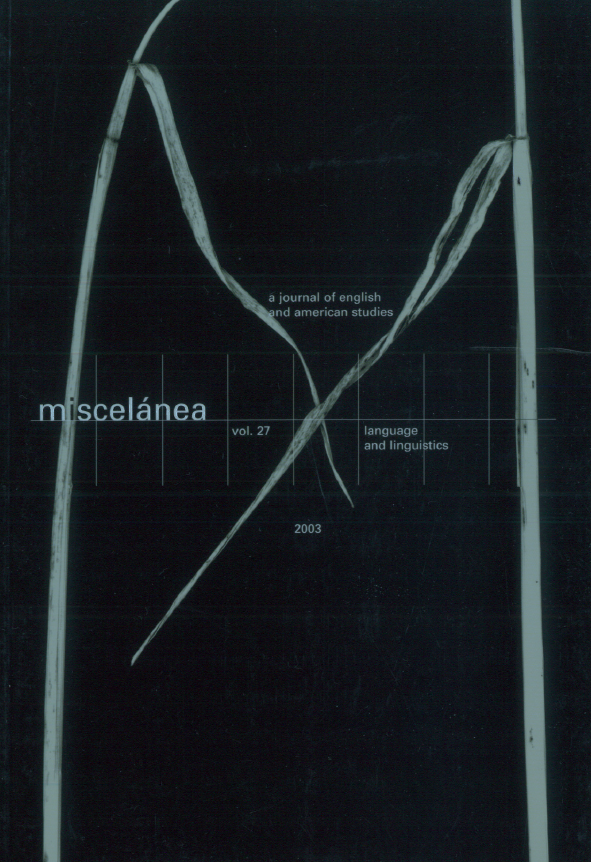La conceptualización gramatical como estrategia poética en yes is a pleasant country de E. E. Cummings
DOI:
https://doi.org/10.26754/ojs_misc/mj.200310398Palabras clave:
proyecciones conceptuales, espacios mentales, integración conceptual, combinación, metáfora, ámbitos de conocimientos, espacio combinado, composición, conclusión, elaboraciónResumen
Este artículo aplica los principios teóricos de la lingüística cognitiva a la composición poética de E.E. Cummings yes is a pleasant country. Combina las perspectivas de la teoría de la metáfora conceptual, la teoría combinada y el modelo de la red de integración conceptual para mostrar cómo la conceptualización gramatical puede utilizarse como estrategia poética, debido al potencial semántico de la gramática, que, como sostiene la lingüística cognitiva, es significativa y simbólica por naturaleza. El artículo también muestra cómo la NIC resulta ser un modelo válido de análisis para las obras poéticas, dado el tipo de conceptualización altamente concentrada e implicada que suelen utilizar. Además, demuestra que los mapeos metafóricos y las mezclas son operaciones mentales diferentes y combinables que forman parte de las complejas proyecciones que se encuentran en las redes conceptuales complejas.
Descargas
Referencias
ADAMS, Jon-K. 1985. Pragmatics and Fiction. Amsterdam: John Benjamins.
BARCELONA, Antonio. (ed.). 2000. Metaphor and Metonymy at the Crossroads. Berlin/New York: Mouton de Gruyter.
COULSON, Seana. 1995. “The Menendez Brothers Virus: Analogical Mapping in Blended Spaces”. In CRL Newsletter. February 1995 9 (1). La Jolla: University of California, San Diego. (Available online at http://crl.ucsd.edu/newsletter/back-issues.html)
COULSON, Seana and Todd OAKLEY. 2000. “Blending Basics”. Cognitive Linguistics. 11 (3/4): 175-196.
CUMMINGS, E. E. 1994 (1944). “yes is a pleasant country”. In Complete Poems, 1904-1962. London: W.W. Norton and Company Books.
FAUCONNIER, Gilles. 1997. Mappings in Thought and Language. Cambridge: Cambridge U.P.
FAUCONNIER, Gilles and Eve SWEETSER. (eds.). 1996. Spaces, Worlds, and Grammar. Chicago: The University of Chicago Press.
FAUCONNIER, Gilles and Mark TURNER. 1994. “Conceptual Projection and Middle Spaces”. La Jolla, CA.: Cognitive Science Technical Report 9401. Available at http://www.inform.umd.edu/EdRes/Colleges/ARHU/Depts/English/englfac/MTurne/
—. 1996. “Blending as a Central Process of Grammar”. In Goldberg, Adele. (ed.). Conceptual Structure, Discourse and Language. Stanford, CA: CSLI: 113-129. Expanded web version available at www.wam.umd.edu/~mturn/WWW/blending.html#ARTICLES
—. 1998. “Conceptual Integration Networks”. Cognitive Science. 22 (2): 133-187.
—. 2000. “Compression and Global Insight”. Cognitive Linguistics. 11 (3/4): 283-304.
—. 2001. “Conceptual Integration Networks”. Expanded web version, 10 February 2001. Available online at http://www.inform.umd.edu/EdRes/Colleges/ARHU/Depts/English/englfac/MTurner/cin.web/cin.html.
GRADY, Joseph. 2000. “Cognitive Mechanisms of Conceptual Integration”. Cognitive Linguistics. 11 (3/4): 335-345.
GRADY, Joseph, Todd OADKLEY and Seana COULSON. 1999. “Blending and Metaphor”. In Steen, Gerard and Raymond Gibbs. (eds.). Metaphor in Cognitive Linguistics. Amsterdam: John Benjamins. Available online at http://cogweb.ucla.edu/CogSci/Grady 99.html
LANGACKER, Ronald. 1987. Foundations of Cognitive Grammar, vol. 1. Stanford: Stanford U. P.
—. Ronald. 1991. Foundations of Cognitive Grammar, vol. 2. Stanford: Stanford U. P.
—. Ronald. 1998. “Indeterminacy in Semantics and Grammar”. In Cifuentes Honrubia, José Luis. (ed.). Estudios de Lingüística Cognitiva II. Alicante: Universidad de Alicante. Departamento de Filología Española, Lingüística General y Teoría de la Literatura: 649-672.
—. Ronald. 2001. “Discourse in Cognitive Grammar”. Cognitive Linguistics 12-2: 143-188.
LAKOFF, George. 1987. Women, Fire and Dangerous Things. Chicago: University of Chicago Press.
—. 1993. “The Contemporary Theory of Metaphor”. In Ortony, Andrew. (ed.). Metaphor and Thought (2nd Ed). Cambridge: Cambridge U. P.: 202-251.
—. 1996. “Sorry, I’m not Myself Today: The Metaphor System for Conceptualizing the Self”. In Fauconnier, Gilles and Eve Sweetser. (eds.) Spaces, Worlds, and Grammar. Chicago: The University of Chicago Press: 91-123.
LAKOFF , George and Mark JOHNSON. 1980. Metaphors We Live By. Chicago: The University of Chicago Press.
—. 1999. Philosophy in the Flesh. New York: Basic Books.
LAKOFF , George and Mark TURNER. 1989. More than Cool Reason. Chicago: The University of Chicago Press.
NAVARRO I FERRANDO, Ignasi. 1999. “The Metaphorical Use of On.” Journal of English Studies 1: 145-164.
RUIZ DE MENDOZA, Francisco J. 1999. Introducción a la Teoría Cognitiva de la Metonimia. Granada: Método Ed.
SÁNCHEZ PALACIOS Ángel L. 2000. Aproximación Cognitiva al Desarrollo Polisémico de la Preposición Inglesa On. Unpublished Doctoral Dissertation. Universidad de Salamanca.
TALMY, Leonard. 2000. Toward a Cognitive Semantics (Vols. I, II). Cambridge, Mass.: The MIT Press.
Descargas
Publicado
Número
Sección
Licencia
Derechos de autor 2003 Pilar Alonso Rodríguez

Esta obra está bajo una licencia internacional Creative Commons Atribución-NoComercial 4.0.


